Well we have had some success in blind pointing the camera at the sky and captured some Starlinks satellites. We will review some upcoming conferences and finish off with some comments and recommendation for Sean Carroll's "Mysteries of Modern Physics."
Here is the Heavens-Above orbit prediction showing the viewing angles from Orange County. The satellites will be very dim and you won't be able to see them with your naked eyes, but the path passed Venus makes it possible to just set up your camera for some blind pointing exposures.
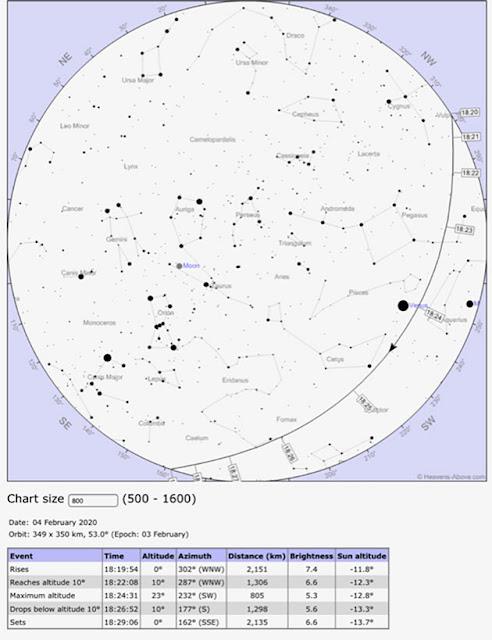 |
| Line of sight opportunity to see Starlink satellites in Orange County, Feb 4 (Source: Heavens-above.com) |
Hooray, I managed to capture at least one of the Starlink satelittes even with city lights polluted views. Hmm, I guess I should have cleaned the DSLR telephoto lens and got rid of any dust bunnies before attempting this!
 |
| Eight second image with airplane upper left, Venus at bottom, and one Starlink at right (Source: Palmia Observatory) |
One of our readers, Science Nerd and Theatre Impresario, Scott, manged to get some excellent satellite tracks across the same night sky. Nice job and thanks, Scott!
 |
| Starlink track in night sky, above Venus (Source: Science Nerd, Scott) |
Ok, that is enough on tracking Starlinks, other than to say that the next launch is scheduled for sometime later in this month, so stay tuned. In the meantime we have two upcoming conferences that might be of interest to astronomers and other physicist wannabes. First, is the 3rd International Planetary Caves Conference, Feb 18-21, 2020. The conference outline lists some of the neat topics about caves and lava tubes on the Moon and Mars and other possible exoplanets. You can check out all of the other details at: https://www.hou.usra.edu/meetings/3rdcaves2020/
See you all there!
 |
| Some fantastic topics at the 3rd International Planetary Caves Conference in San Antonio, Feb 18-21, 2020 |
The other upcoming conference is the 3rd World Summit on "Exploring the Dark Side of the Universe." This conference is on the tropical island paradise of Guadaloupe on March 9-13. This might be where you need to check out your world map or globe to find that Guadaloupe is one of the 20 Caribbean islands that make up the Lesser Antilles, which arcs almost down to South America. The conference dark topics (no voodoo is not one of them) include dark energy, dark matter, neutrinos and how they all affect cosmology. I am hoping to put this on my calendar. You can check out all of the other details at: https://indico.cern.ch/event/801461/overview
 |
| Create your own quantum superposition of physics, beaches and rum in paradise (Source: "Exploring the Dark Side of the Universe") |
After seeing the announcement for the dark side of physics conference, I couldn't help but think of an old BBC TV series "Death in Paradise" about a police detective and team on the fictional island of Saint Marie. It was fun watching this series and and the end of each episode the police would gather at their favorite island bar for rum and fun. Spending time on some island in the Caribbean always sounded fun, so I just had to upgrade the series poster to proclaim " Physics in Paradise." So, sign up and we will see you there!
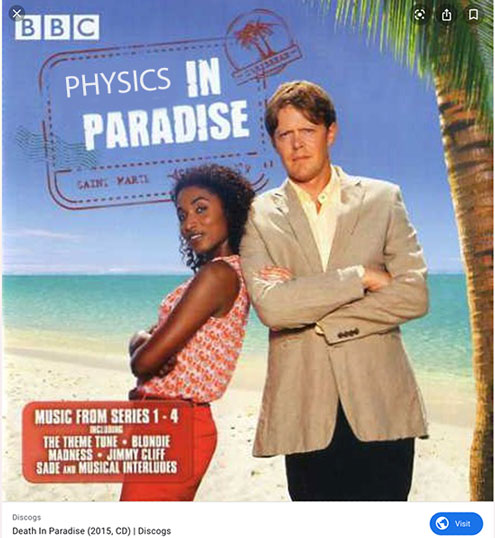 |
| Re-imagined TV Series, "Physics in Paradise" (Source: BBC series, "Death in Paradise") |
Finally, we finish up with another one of Sean Carroll's fantastic videos, this time on the mysteries of physics. You can check out the entire video at: https://sms.cam.ac.uk/media/3148863
and I will summarize and comment on one of the mysteries on reconciling gravity with quantum mechanics and how might gravity emerge from quantum entanglement. If you find this stuff interesting, be sure to check out the video because Sean explains it all in more detail and better than I can.
One of the mysteries is what is the makeup of the 95% of the mass/energy summation of the universe that is not understood. Lots of theories, but not yet much evidence.
 |
| The mystery of the 95% of the universe that is not understood (Source: Sean Carroll, "Mysteries of Modern Physics") |
The mystery that I was most interested in was how to reconcile our world, apparently made of particles, and yet perhaps the best theoretical understanding comes from viewing the world as made up of fields and how all of this relates to theories of gravity. In this approach, the particles are to be thought of as just energized locations of the fields.
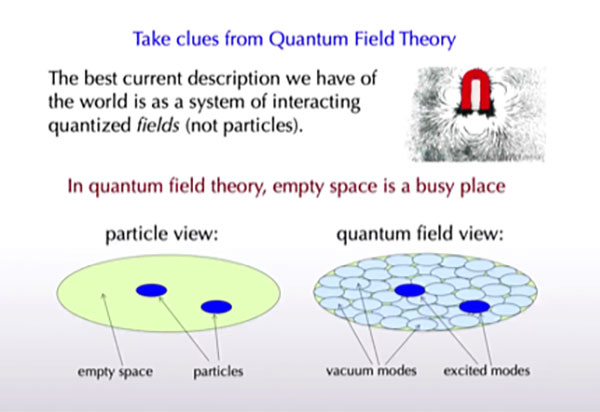 |
| We see particles, but better understood as waves (Source: Sean Carroll, "Mysteries of Modern Physics") |
With this introduction to one of the mysteries we can follow along with Sean as he transitions to approach using quantum fields to resolve his 2nd mystery: The Emergence of Spacetime and Gravity. We know from the study of general relativity that all of the mathematics goes into showing how the geometry of the gravitational field is tied up with the amount of energy, which is the source of curvature.
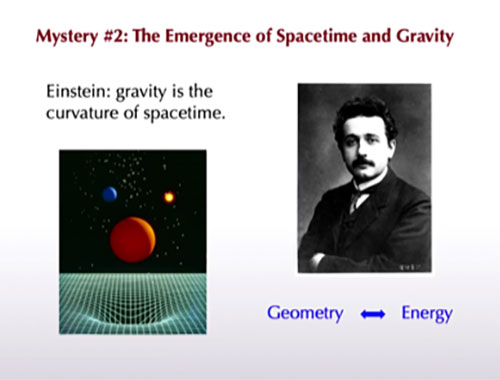 |
| General relativity is a classical equating of geometry & energy (Source: Sean Carroll, "Mysteries of Modern Physics") |
So, if the best description comes from fields and Quantum Field Theory, Sean goes on to explain that it might be the best way to unify gravity with quantum mechanics is to start from quantum mechanics and derive gravity rather than starting with gravity, using the classical theory of general relativity, and trying to quantize it. This is outlined in the screenshot from Sean's presentation.
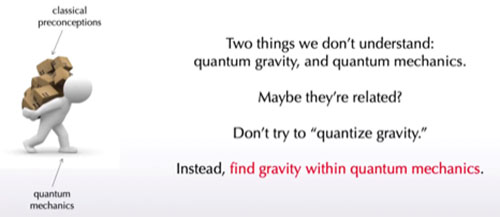 |
| Begin with quantum mechanics and derive gravity (Source: Sean Carroll, "Mysteries of Modern Physics") |
So, what Sean says he is working on is how to work through all the mathematics to do this. The outline of the approach is to describe the geometry of spacetime in terms of entanglement between regions of space. Yep, this entanglement is the same as found in "spooky action at a distance" type discussions in quantum mechanics.
 |
| General relativity is a classical equating of geometry & energy (Source: Sean Carroll, "Mysteries of Modern Physics") |
So, if this approach that many people are working on is successful then we will see a theory that shows the relationship between geometry, energy and entanglement. Bringing entanglement into the picture is how the quantum fields are incorporated and hopefully will explain how gravity can be derived from the quantum mechanics and wave functions of the fields. Keep going Sean (and others)!
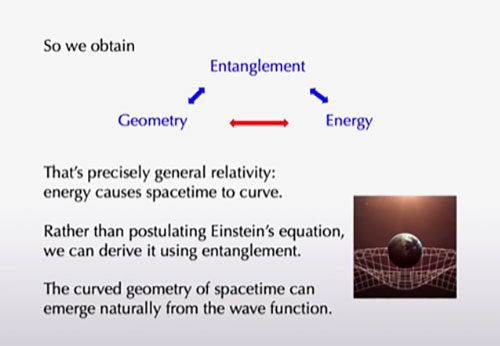 |
| Tying it all together will be fantastic if it works (Source: Sean Carroll, "Mysteries of Modern Physics") |
Sean concludes the video with some considerations about complexity. We understand that the universe started at the big bang in a state of very low entropy and low complexity. Then as the universe evolves and galactic structures form, the complexity increases. But even further in the future as the universe thins out through expansion, complexity declines. We live it seems right in the middle of history where complexity is possible. It is a case that being too early in the life of the universe does not support complexity, like that in planets and creatures, like us, and neither does the much later life of the universe.
 |
| The middle ages of the universe is where we can live (Source: Sean Carroll, "Mysteries of Modern Physics") |
Ok, on that thought about being lucky to be here in the middle ages of the universe, we have one last minute news item from our Twitter buddy, Felix, who just provided an update on the launch schedule for the Starship test hop from Boca Chica, TX, no earlier than (NET) March 16. So, keep your travel schedule open and let's meet up in Boca Chica when the test is actually announced! I don't have any cowboy boots anymore but this is still something we should put on our calendars!
 |
| New and old transportation vehicles in Boca Chica (Source: @BocaChicaGal) |
Until next time,
Resident Astronomer George
Be sure to check out over 300 other blog posts on similar topics
If you are interested in things astronomical or in astrophysics and cosmology
Check out this blog at www.palmiaobservatory.com

No comments:
Post a Comment